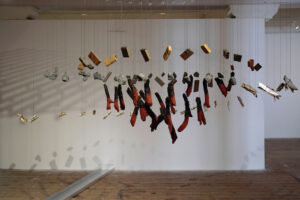Class Resource Readings and Post-Class Independent Study
Place-specific art not only taps into repressed histories and provides greater visibility to marginalized groups and issues, but also interrogates place’s social and historical dimensions (Kwon, 1997). By situating artworks within wider cultural and social contexts, as mentioned in Contextualization, artists, and curators have begun to explore how they can intervene in the public sphere and community life through their artistic practice (Doherty, 2009). However, how do you ensure that art projects truly reflect and respond to the needs and aspirations of the community, rather than simply using the community as the context or object of art practice? I think it exposes the challenge of achieving this understanding in practice: how to avoid the potentially exploitative and superficial involvement of arts projects in communities, and to ensure that arts practice contributes to genuine social dialogue and change, is something that must be seriously considered as site-specific arts continue to evolve. In addition to this, we explored the concepts of site-responsive and site-sensitive art, and how they can affect the audience experience.
I independently researched Julie Louise Bacon’s curatorial project on artists exploring the relationship between time and place as a means of influencing human perception and action, Habitat of Time (Arts Catalyst, 2020), as this echoed the course’s focus on artists and curators intervening in the public realm and community life by situating artworks in wider cultural and social contexts. public realm and community life by placing artworks in a wider cultural and social context. The works I viewed in the exhibition included James Guerts’ Trajectories II-Prebiotica (geological and cosmic dimensions of time using ancient meteorite material) and Robert Andrew’s Detail of Disruptive (Ill) Logic (symbolic of the power of materials and technology to shape relationships with time), both of which explored the power of materials and technology to shape relationships with time. and Robert Andrew’s ‘Detail of Disruptive (Ill) Logic’ (symbolizing the power of materials and technology to shape relationships with time), both explore the multidimensional experience of time, presenting the plasticity of time while suggesting its relevance to geological, technological, biological and cosmic scales. This multidimensional conception of time overturns anthropocentric understandings of time and proposes a conception of time that is deeply interconnected with the non-human world. This directly echoes the content of this week’s course that I mentioned at the beginning. The exhibition demonstrates the multidimensional nature of the site’s physical characteristics, historical context, and other characteristics interacting with the artwork.

Robert Andrew, detail of Disruptive (Ill) Logic, 2017, pearl shell, rocks, etched blue stone, ocher, iron oxide, tree branches, string, 240 × 240 × 280 cm. Courtesy of the artist and Metro Arts, Brisbane

James Geurts, Trajectories II-Prebiotica, 2019; image courtesy the artist
Group Workshop with CAP students
Assigned to GroupA, I had the pleasure of discussing with fellow Contemporary Art Practice student Siri about potential exhibition venues for her curatorial theme ‘Holy Collection’. She seeks to enhance audience engagement with her work by presenting it in a location that is closely related to Scottish folklore. I believe that the Anatomy Museum at the University of Edinburgh, with its unique historical context and the echo of the concept of ‘artifacts’, provides an ideal space for Siri’s work (Kwon, 1997). This is because Siri aims to convey folktale meanings through material forms such as ceramic plates, which resonate with the Anatomical Museum’s attributes as a witness to history. The unique environment of the Anatomy Museum stimulates the audience’s curiosity and desire to explore the subject matter of the exhibition. At the same time, the ambiance and historical depth of the venue was able to enhance the attractiveness of the work, thereby increasing audience engagement. The rest of the group mentioned that historic buildings or modern art spaces in Edinburgh’s New Town, for example, could also provide Siri’s project with an environment with fluidity and diversity in time and space (Bishop, 2005).
University of Edinburgh. (2019). Anatomical Museum Virtual Tour. Available at: https://www.ed.ac.uk/visit/museums-galleries/anatomical (Accessed: 17 March 2024)
References:
Arts Catalyst. (2020). The Habitat of Time. [Online] Available at: https://www.fact.co.uk/news/2018/04/dr-julie-louise-bacon-visits-fact-from-sydney-as-part-of-major-international-research-project (Accessed: 20 March 2024).


